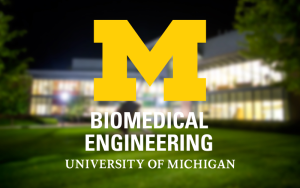Presented By: Biomedical Engineering
“The role of muscle activity in structure-function relationships of embryonic tendon development”
BME 500 Seminar: Spencer Szczesny, Ph.D.

BME 500 Seminar Series
Thursday, October 28, 2021
4:00 – 5:00 pm
Zoom Link: https://umich.zoom.us/j/97723483179
Spencer Szczesny, Ph.D.
Biomedical Engineering,
Pennsylvania State University
“The role of muscle activity in structure-function relationships of embryonic tendon development”
Abstract:
While there is significant interest in using tissue engineering techniques to create tendon and ligament replacements, no engineered biomaterial has been successful in replicating their physiological function. This is because there is a fundamental lack of understanding of how to produce a robust tensile load-bearing biological tissue. Previous work suggests that tendon maturation is driven by rapid increases in collagen fibril length and molecular crosslinking mediated by mechanical stimulation due to muscle activity. However, the effect of mechanical stimulation on the tensile mechanics of developing tendons and the functional significance of the structural changes that occur during development are still unclear. To address this knowledge gap, we investigated the multiscale structure-function relationships of embryonic tendons during normal development and following the loss of mechanical stimulation via immobilization. Using multiscale mechanical testing, we found that the strain transmitted to the collagen fibrils in tendons at embryonic days 16, 18, and 20 is less than the strain applied to the tissue, suggesting the collagen fibrils remain discontinuous throughout embryonic development. However, the ratio of the fibril strains to the tissue strains increased with developmental age; this indicates that more strain is being transmitted to the fibrils and that there is less interfibrillar sliding, which is consistent with an increase in the average fibril length and an increase in the macroscale mechanics during this period of development. Additionally, there was a decrease in the macroscale tensile modulus and the fibril:tissue strain ratio with flaccid (but not rigid) immobilization, suggesting that complete loss of mechanical stimulation inhibits fibril elongation and strain transmission to the collagen fibrils, resulting in impaired functional maturation. Consistent with these mechanical assessments, we found that collagen fibril bundling was impaired with immobilization. Interestingly, while the enthalpy required to denature the tendons increased with increasing age, there was no effect with immobilization. This suggests that although intermolecular crosslinks in embryonic tendons increase with development, the loss of tensile mechanical properties with immobilization is potentially not due to a reduction in functional crosslinking. Together, these data suggest that the key structural change induced by mechanical stimulation during tendon development is an increase in the strain transmitted to the collagen fibrils, which is consistent with fibril elongation. These data provide fundamental insight into the mechanisms driving tendon development and will guide the design of improved techniques for engineering tendon/ligament replacements.
Thursday, October 28, 2021
4:00 – 5:00 pm
Zoom Link: https://umich.zoom.us/j/97723483179
Spencer Szczesny, Ph.D.
Biomedical Engineering,
Pennsylvania State University
“The role of muscle activity in structure-function relationships of embryonic tendon development”
Abstract:
While there is significant interest in using tissue engineering techniques to create tendon and ligament replacements, no engineered biomaterial has been successful in replicating their physiological function. This is because there is a fundamental lack of understanding of how to produce a robust tensile load-bearing biological tissue. Previous work suggests that tendon maturation is driven by rapid increases in collagen fibril length and molecular crosslinking mediated by mechanical stimulation due to muscle activity. However, the effect of mechanical stimulation on the tensile mechanics of developing tendons and the functional significance of the structural changes that occur during development are still unclear. To address this knowledge gap, we investigated the multiscale structure-function relationships of embryonic tendons during normal development and following the loss of mechanical stimulation via immobilization. Using multiscale mechanical testing, we found that the strain transmitted to the collagen fibrils in tendons at embryonic days 16, 18, and 20 is less than the strain applied to the tissue, suggesting the collagen fibrils remain discontinuous throughout embryonic development. However, the ratio of the fibril strains to the tissue strains increased with developmental age; this indicates that more strain is being transmitted to the fibrils and that there is less interfibrillar sliding, which is consistent with an increase in the average fibril length and an increase in the macroscale mechanics during this period of development. Additionally, there was a decrease in the macroscale tensile modulus and the fibril:tissue strain ratio with flaccid (but not rigid) immobilization, suggesting that complete loss of mechanical stimulation inhibits fibril elongation and strain transmission to the collagen fibrils, resulting in impaired functional maturation. Consistent with these mechanical assessments, we found that collagen fibril bundling was impaired with immobilization. Interestingly, while the enthalpy required to denature the tendons increased with increasing age, there was no effect with immobilization. This suggests that although intermolecular crosslinks in embryonic tendons increase with development, the loss of tensile mechanical properties with immobilization is potentially not due to a reduction in functional crosslinking. Together, these data suggest that the key structural change induced by mechanical stimulation during tendon development is an increase in the strain transmitted to the collagen fibrils, which is consistent with fibril elongation. These data provide fundamental insight into the mechanisms driving tendon development and will guide the design of improved techniques for engineering tendon/ligament replacements.